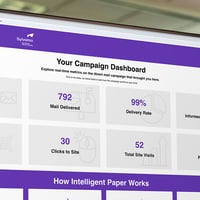4 Ways to Make Your Next Print Project More Sustainable
When designing for print, designers will often look for creative ways to economize for budgetary reasons; sometimes a clever tweak to a design can help the project to maximize the space on a single sheet of paper, use less ink or reduce the cost of postage.
But it’s not just costs designers are concerned about; there are environmental reasons to think this way, too. Strategically creating print pieces to reduce environmental impact starts in the concept phase, but designers have the power to reduce and reuse throughout the process, especially when specifying job requirements to their print partners.
Here are four steps that you can take to make your next print project more sustainable.
Opt for Digital Printing
When it comes to sustainability, the type of press your printer uses matters. Digital printing is more sustainable than traditional offset printing, for a number of reasons. First, it eliminates the printing plates and chemicals associated with the offset prepress process. And unlike toner printing, there are no cartridges to worry about. Plus, you can do a lot of your press proofing digitally.
The other big shift with digital printing is that you can print only the number of pieces you need. In the offset world, small press runs simply don’t make sense because so much setup has to be done to do a run at all. For this reason, those printing offset will often print more than they need to bring the per-piece price down, even if it means part of the run will sit in storage or eventually go to waste.
With digital printing, however, it’s possible to print on demand. If you need to do a small run now and another small run later, you can, which can mean big savings on resources.
Choose Eco-Friendly Inks
Not all inks are equal. To reduce your project’s impact on the environment, look for no- or low-VOC inks. VOCs (volatile organic compounds) are chemicals that are released into the air from common household or work products, and petroleum-based inks are higher in VOCs than some of the green alternatives available today. Vegetable-based inks, which are usually made with soy, linseed, canola or safflower oil, are good low-VOC options.
Spec Paper Made from Post-Consumer Materials
Today’s designers have a plethora of recycled paper options to choose from. In addition to paper made from post-consumer fibers, like Accent® Opaque RE-30, there are even papers made from other recycled products, such as used coffee cups.
As you consider your paper options, consider the company that manufacturers the paper as well. Knowing where your paper comes from means tracing it back through the paper supply chain; who produced it, and did it come from a responsibly managed working forest? Most paper brands are part of larger companies (for example, Accent Opaque is part of Sylvamo), so start by researching the manufacturer to get answers to your sustainability questions.
Choose a Print Services Partner Who Shares Your Values
It will be easier to opt for digital printing and specify recycled paper and eco-friendly inks if you partner with a printer who shares your commitment to sustainability. Let your printer know early on in the process that reducing your environmental impact is important to you. Ask them about their own sustainability initiatives; can they describe their recycling programs, where they get their energy and other investments they’ve made in environmentally friendly equipment or processes?
Printers who are committed to minimizing their own impact will be happy to share these details with you — and they’ll probably be able to recommend even more ways you improve the eco-friendliness of your project.
Want to learn more about Sylvamo and our commitment to sustainability? Download Did You Know?: Meet Sylvamo.





